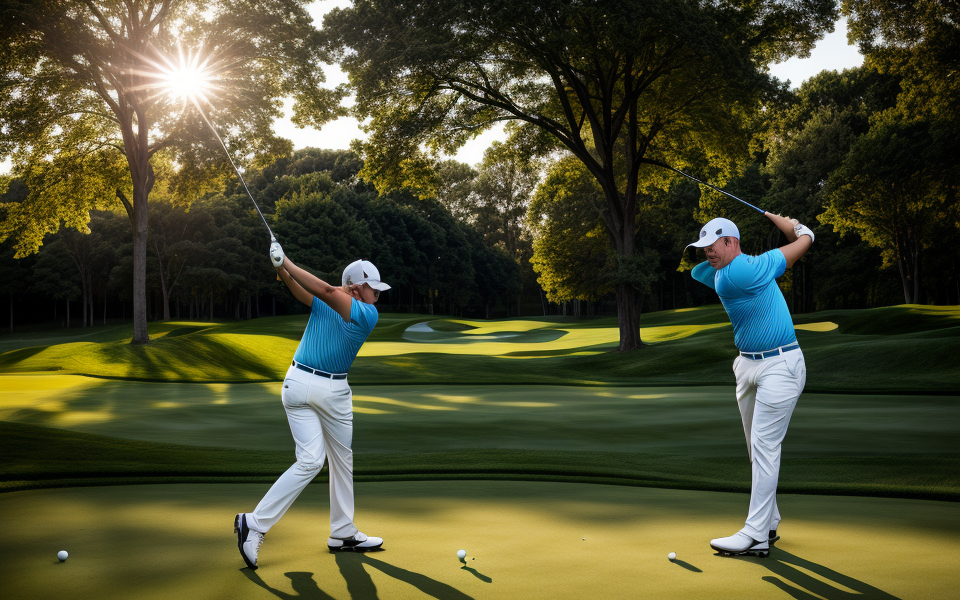Golf is a sport that requires precision, focus, and physical prowess. While many people assume that being fit is essential for success in golf, the truth is that it’s not always the case. Some of the best golfers in the world have been known to be less than fit, relying more on their skills and mental toughness to achieve success on the course. However, as golf courses become longer and more challenging, the question remains: is fitness essential for success in golf? In this article, we will explore the relationship between fitness and golf performance, and examine the factors that contribute to success on the course. Whether you’re a seasoned golfer or just starting out, this article will provide valuable insights into the role of fitness in the sport of golf.
Yes, fitness is essential for success in golf. Golf is a physically demanding sport that requires strength, endurance, and flexibility. A fit and strong body can help golfers to improve their swing, increase their distance, and reduce the risk of injury. Fitness also helps golfers to maintain focus and concentration during long rounds, which is crucial for success in the sport. In addition, fitness can improve overall health and well-being, which can have a positive impact on golf performance. Therefore, incorporating a fitness routine into a golf training program is crucial for success in golf.
Importance of physical fitness in golf
Physical fitness plays a crucial role in the success of a golfer. The following points highlight the importance of physical fitness in golf:
Increased swing speed and power
A golfer with a high level of physical fitness is likely to have increased swing speed and power. Physical fitness helps to develop muscle strength and endurance, which can result in more distance and accuracy in shots. A strong core, legs, and arms are essential for generating power in the swing.
Improved mobility and flexibility
Physical fitness helps to improve mobility and flexibility, which is crucial for a golfer’s performance. Good mobility allows for a more efficient and effective swing, while flexibility helps to prevent injury and maintain a proper golfing posture. Regular exercise and stretching can help golfers maintain their mobility and flexibility.
Better body control and balance
Physical fitness also helps to improve body control and balance, which is important for maintaining a stable stance during the swing. Golfers who are physically fit are more likely to maintain their balance throughout the swing, resulting in more accurate shots. Physical fitness exercises such as yoga and Pilates can help to improve body control and balance.
Increased endurance and stamina
Physical fitness also helps to increase endurance and stamina, which is crucial for golfers who play long rounds. A golfer who is physically fit is more likely to maintain their energy levels throughout the round, resulting in better performance. Regular exercise and cardiovascular training can help to improve endurance and stamina.
Reduced risk of injury
Finally, physical fitness helps to reduce the risk of injury. Golfers who are physically fit are less likely to suffer from injuries such as back pain, tendinitis, and muscle strains. Regular exercise and stretching can help to prevent injuries and maintain good physical health.
In conclusion, physical fitness is essential for success in golf. Golfers who are physically fit are more likely to perform better, have improved mobility and flexibility, better body control and balance, increased endurance and stamina, and reduced risk of injury. Regular exercise and physical fitness training can help golfers to improve their performance on the golf course.
Cardiovascular health
In golf, cardiovascular health plays a crucial role in determining a player’s performance. A player’s endurance level can significantly impact their ability to sustain physical activity over an extended period. Golf is a sport that requires both short bursts of energy and long periods of sustained effort.
Aerobic capacity is a measure of the amount of oxygen an individual can consume during exercise. It is an essential component of cardiovascular health and is directly related to endurance. A higher aerobic capacity allows a golfer to sustain physical activity for longer periods, which is essential for success in the sport.
In addition to endurance, cardiovascular health also impacts the ability to recover between shots and holes. A player with better cardiovascular health will be able to recover more quickly, reducing the risk of fatigue and exhaustion. This increased recovery time can be critical during a long tournament, where players are required to maintain their performance over multiple days.
Furthermore, cardiovascular health also impacts the ability to control and manage stress. Golf is a sport that requires mental focus and control, and a player’s ability to manage stress can significantly impact their performance. Players with better cardiovascular health are more likely to maintain a stable heart rate and blood pressure, which can help reduce stress and anxiety.
Overall, cardiovascular health is a critical component of physical fitness for golfers. A player’s endurance, recovery time, and ability to manage stress are all directly impacted by their cardiovascular health. Therefore, it is essential for golfers to prioritize cardiovascular fitness as part of their training regimen.
Strength and flexibility
- How muscle strength and flexibility impacts golf shots
- Improved swing speed and power
- Increased accuracy and control
- Reduced risk of injury
- Importance of proper muscle balance
- Maintaining a balanced body to improve stability and control during swings
- Preventing muscle imbalances that can lead to injury or decreased performance
- Customized exercise programs to target specific muscle groups for golf-related movements
Muscle strength and flexibility play a crucial role in the success of a golfer. A well-conditioned body can improve the overall performance of a golfer, leading to increased swing speed, power, accuracy, and control. Strength training exercises can help to develop the muscles needed for a powerful and accurate swing, while flexibility exercises can improve range of motion and reduce the risk of injury.
Improved muscle strength can lead to a more powerful swing, resulting in longer drives and more accurate shots. Additionally, strength training can help to improve overall body control, allowing for better balance and stability during swings. This improved control can also reduce the risk of injury, as a strong and stable body is better able to withstand the physical demands of golf.
Flexibility is also an important aspect of physical fitness for golfers. Golf swings require a full range of motion, and limited flexibility can lead to decreased accuracy and control. Flexibility exercises can help to improve range of motion, allowing for a more fluid and controlled swing. Additionally, maintaining proper muscle balance is important to prevent muscle imbalances that can lead to injury or decreased performance.
Customized exercise programs can be designed to target specific muscle groups used in golf-related movements. For example, exercises that focus on the core, upper body, and legs can help to improve overall stability and control during swings. A well-rounded fitness program that includes both strength and flexibility training can lead to improved performance on the golf course and a reduced risk of injury.
Mental focus
Physical fitness plays a crucial role in golf as it directly affects the mental focus of a player. Mental focus is the ability to concentrate and stay attentive during a game. Golf requires a high level of mental focus as it is a game of precision and accuracy.
- Physical fitness and mental focus are interconnected. Physical fitness helps to improve mental focus by reducing stress and anxiety, increasing energy levels, and improving overall well-being. A physically fit golfer is better equipped to handle the mental demands of the game.
- Mental focus is critical in golf as it helps players to stay focused on the task at hand, avoid distractions, and make split-second decisions. A golfer who lacks mental focus may find it difficult to maintain concentration, leading to poor performance on the course.
- Physical fitness can help to improve mental focus by reducing physical discomfort and distractions. For example, a golfer who is physically fit is less likely to experience muscle soreness or fatigue, which can be a significant distraction during a game. Additionally, physical fitness can help to improve overall energy levels, allowing golfers to stay focused and alert throughout the game.
- Mental focus is not the only factor that affects golf performance, but it is an essential one. Golfers who have high levels of mental focus are better able to block out distractions, maintain concentration, and make confident decisions on the course. Physical fitness can help to improve mental focus by reducing stress and anxiety, which can be significant distractions during a game.
- Golfers who are physically fit are also better equipped to handle the physical demands of the game. Physical fitness can help to improve endurance, reduce the risk of injury, and increase the golfer’s overall performance. Additionally, physical fitness can help to improve the golfer’s overall health and well-being, which can have a positive impact on mental focus.
In conclusion, physical fitness is essential for success in golf, as it directly affects the mental focus of a player. Golfers who are physically fit are better equipped to handle the mental demands of the game, reducing stress and anxiety, increasing energy levels, and improving overall well-being. A physically fit golfer is better able to maintain concentration, make confident decisions, and perform at their best on the course.
Benefits of incorporating fitness into golf training
Improved physical abilities
- Enhanced muscular strength and endurance
- Increased flexibility and mobility
- Greater cardiovascular fitness
Better mental focus and resilience
- Improved concentration and decision-making
- Enhanced ability to handle stress and adversity
-
Increased self-confidence and motivation
-
Strengthened muscles and joints
- Improved balance and stability
- Prevention of overuse injuries
Improved overall performance
- Increased distance and accuracy
- Greater control over ball flight
- Enhanced ability to handle different golf course conditions
By incorporating fitness into their golf training, golfers can enjoy these benefits and potentially improve their overall success on the golf course.
Improved swing speed and power
Incorporating physical fitness into golf training has numerous benefits, one of which is improved swing speed and power. Swing speed and power are crucial factors in golf, as they determine the distance and accuracy of a player’s shots. Here’s how physical fitness can enhance swing mechanics and increase clubhead speed and distance:
- Improved muscle strength and flexibility: Physical fitness exercises such as weightlifting, stretching, and yoga can help improve muscle strength and flexibility, which are essential for a powerful and accurate golf swing. Strong muscles enable players to generate more force and control behind their swings, resulting in increased clubhead speed and distance.
- Increased joint mobility: Fitness exercises that focus on joint mobility, such as dynamic stretches and mobility drills, can help golfers achieve a wider range of motion in their joints. This increased joint mobility allows players to make more efficient and powerful swings, as they can reach further and rotate their bodies more freely.
- Better body control and balance: Physical fitness can also improve a golfer’s body control and balance, which are essential for maintaining a stable and efficient swing. Exercises that focus on core strength, stability, and proprioception can help golfers develop the necessary balance and control to make accurate and powerful swings.
- Enhanced energy and endurance: Incorporating cardiovascular exercises into a fitness routine can help golfers improve their energy and endurance on the course. Physical fitness can increase the body’s ability to recover between shots and during rounds, reducing fatigue and allowing players to maintain their swing speed and power throughout the game.
Overall, physical fitness plays a crucial role in improving swing speed and power in golf. By incorporating fitness exercises into their training regimen, golfers can enhance their muscle strength and flexibility, increase joint mobility, develop better body control and balance, and improve their energy and endurance on the course.
Reduced risk of injury
Incorporating fitness into golf training can significantly reduce the risk of injury. Golfers who are physically fit are less likely to experience injuries such as muscle strains, tendinitis, and stress fractures. This is because physical fitness helps to improve the overall strength and flexibility of the body, which can help to prevent injuries.
One of the most common injuries in golf is a golfer’s elbow, which is caused by repetitive strain on the elbow joint. Physical fitness can help to prevent this injury by strengthening the muscles in the forearm and shoulder, which can help to reduce the strain on the elbow.
Another injury that is common in golf is a lower back injury, which can be caused by the repetitive twisting and bending motions required in the swing. Physical fitness can help to prevent this injury by strengthening the muscles in the lower back and improving flexibility, which can help to support the spine and reduce the risk of injury.
In addition to reducing the risk of injury, physical fitness can also improve a golfer’s performance on the course. By improving strength, endurance, and flexibility, golfers can increase their power and accuracy, which can lead to better shot-making and lower scores.
Overall, incorporating fitness into golf training is essential for any golfer who wants to reduce their risk of injury and improve their performance on the course.
Enhanced overall health and well-being
- Improved cardiovascular health
- Increased muscular strength and endurance
- Reduced risk of injury
- Improved mental well-being
Improved cardiovascular health is a key benefit of incorporating fitness into golf training. Golf, like any other sport, requires players to cover long distances, sometimes carrying heavy bags, and can be physically demanding. As a result, it is important for golfers to have good cardiovascular fitness to endure the physical demands of the game. Regular cardiovascular exercise such as running, cycling, or swimming can help golfers improve their cardiovascular health and increase their endurance on the golf course.
In addition to improved cardiovascular health, incorporating fitness into golf training can also lead to increased muscular strength and endurance. Golf requires players to have strong muscles in their legs, core, and upper body. Strength training exercises such as weightlifting, resistance bands, and bodyweight exercises can help golfers build the necessary muscle strength to improve their swing and overall game.
Furthermore, regular exercise can also help reduce the risk of injury in golfers. Golf can be a physically demanding sport, and injuries such as back pain, knee injuries, and elbow pain are common among golfers. Incorporating strength and flexibility exercises into their fitness routine can help golfers prevent these injuries and stay in top physical condition.
Lastly, incorporating fitness into golf training can also have a positive impact on mental well-being. Golf is a mentally demanding sport, and the pressure to perform well can be overwhelming. Regular exercise has been shown to reduce stress and anxiety, and can help golfers stay focused and mentally sharp on the golf course.
In conclusion, incorporating fitness into golf training can have numerous benefits for golfers, including improved cardiovascular health, increased muscular strength and endurance, reduced risk of injury, and improved mental well-being. By incorporating regular exercise into their routine, golfers can enhance their overall health and well-being, and improve their performance on the golf course.
Strategies for incorporating fitness into golf training
Warm-up and cool-down exercises
Warm-up exercises are crucial in preparing the body for physical activity, and they should be a part of every golfer’s pre-round routine. These exercises can include dynamic stretches, such as leg swings and arm circles, to increase blood flow and mobilize the joints. Similarly, cool-down exercises should be performed after the round to help the body recover and reduce the risk of injury.
Cardiovascular exercises
Cardiovascular exercises, such as running and cycling, are essential for improving endurance and reducing the risk of heart disease. Golfers can incorporate these exercises into their training routine by running on a treadmill or cycling on a stationary bike, both of which can be found at most golf courses. These exercises can also be done outdoors, and they are particularly beneficial for golfers who walk the course during play.
Resistance training
Resistance training, such as weightlifting and resistance band exercises, is essential for building strength and improving power. Golfers can incorporate these exercises into their training routine by working with a personal trainer or by following a workout plan that can be done at home or in the gym. These exercises are particularly beneficial for improving the strength of the core, which is essential for maintaining balance and power during the swing.
Flexibility and mobility exercises
Flexibility and mobility exercises, such as yoga and Pilates, are essential for improving the range of motion and reducing the risk of injury. Golfers can incorporate these exercises into their training routine by attending a class or by following a workout plan that can be done at home. These exercises are particularly beneficial for improving the flexibility of the hips and shoulders, which are essential for making a full shoulder turn during the swing.
Balance and stability exercises
Balance and stability exercises, such as single-leg squats and planks, are essential for improving the stability and balance of the body. Golfers can incorporate these exercises into their training routine by following a workout plan that can be done at home or in the gym. These exercises are particularly beneficial for improving the stability of the core, which is essential for maintaining balance and power during the swing.
Overall, incorporating fitness into golf training is essential for improving physical performance and reducing the risk of injury. Golfers can use a variety of strategies, including warm-up and cool-down exercises, cardiovascular exercises, resistance training, flexibility and mobility exercises, and balance and stability exercises, to achieve these goals.
Fitness routines for golfers
As a golfer, it is important to have a fitness routine that caters to the specific demands of the sport. A well-rounded fitness program can help improve overall performance, reduce the risk of injury, and increase longevity in the game. Here are some strategies for incorporating fitness into golf training:
- Customized fitness programs for golfers
A customized fitness program is essential for golfers, as it takes into account their individual needs and goals. A personal trainer or fitness coach who specializes in golf fitness can help design a program that includes exercises that target the muscles used in golf swings, such as the core, legs, and upper body.
- Incorporating strength and flexibility exercises
Strength and flexibility exercises are crucial for golfers. Strength training can help improve power and endurance, while flexibility exercises can help improve range of motion and reduce the risk of injury. Exercises such as squats, lunges, and deadlifts can help build lower body strength, while exercises such as planks and yoga can help improve core stability and flexibility.
In addition to these exercises, golfers should also incorporate cardiovascular exercises into their fitness routine. Cardio exercises such as running, cycling, and swimming can help improve endurance and cardiovascular health, which is essential for playing 18 holes without fatiguing.
Overall, incorporating fitness into golf training is essential for success on the course. A customized fitness program that includes strength, flexibility, and cardiovascular exercises can help golfers improve their performance, reduce the risk of injury, and increase longevity in the sport.
Incorporating fitness into practice sessions
- Warm-up and cool-down exercises
- The Importance of Warm-up Exercises
- Preparing the Muscles for Physical Activity
- Reducing the Risk of Injury
- Sample Warm-up Exercises
- Light Cardiovascular Exercise (e.g., jogging or cycling)
- Dynamic Stretching (e.g., leg swings or arm circles)
- The Importance of Cool-down Exercises
- Returning the Body to a State of Rest
- Aiding in Recovery and Reducing Muscle Soreness
- Sample Cool-down Exercises
- Gentle Stretching (e.g., hamstring stretches or calf stretches)
- Deep Breathing Techniques
- The Importance of Warm-up Exercises
- Drills to improve physical performance
- The Importance of Physical Conditioning in Golf
- Increasing Strength and Endurance
- Improving Power, Speed, and Accuracy
- Sample Drills for Physical Conditioning
- Resistance Training (e.g., using weights or resistance bands)
- Plyometric Exercises (e.g., jump squats or box jumps)
- Integrating Physical Conditioning into Practice Sessions
- Scheduling Time for Fitness Drills
- Incorporating Fitness Goals into Practice Objectives
- The Benefits of Incorporating Fitness into Practice Sessions
- Improved Performance on the Golf Course
- Reduced Risk of Injury
- Enhanced Overall Health and Well-being
- The Importance of Physical Conditioning in Golf
Nutrition and hydration for golfers
Proper nutrition is essential for golfers to maintain their energy levels and enhance their performance on the golf course. A well-balanced diet that includes a variety of fruits, vegetables, whole grains, lean proteins, and healthy fats can provide the necessary nutrients for optimal golf performance.
Hydration is also crucial for golfers, as it helps to maintain fluid balance and regulate body temperature. Dehydration can lead to fatigue, dizziness, and other performance-impairing effects, so it’s important for golfers to stay hydrated throughout their round.
Here are some tips for maintaining proper nutrition and hydration while playing golf:
- Pre-round meal: Eat a well-balanced meal a few hours before teeing off. This should include carbohydrates to provide energy, protein to support muscle repair, and healthy fats to support brain function.
- Snacks: Bring healthy snacks such as fruit, nuts, and protein bars to eat between holes or during long breaks in play.
- Stay hydrated: Drink water or sports drinks regularly throughout the round to maintain hydration levels. Avoid alcohol and caffeine, as they can dehydrate the body and impair performance.
- Listen to your body: If you’re feeling fatigued or lightheaded, take a break and eat or drink something to re-energize.
By incorporating these strategies into their golf training, players can optimize their physical conditioning and improve their performance on the course.
FAQs
1. Is there a correlation between physical fitness and golf performance?
Yes, there is a strong correlation between physical fitness and golf performance. Physical fitness helps golfers improve their overall health, endurance, and strength, which are crucial for executing shots and managing their bodies throughout a round of golf.
2. How does physical fitness affect different aspects of golf?
Physical fitness affects different aspects of golf, including:
* Swing power and control
* Endurance for long rounds
* Balance and stability
* Mobility and flexibility
* Mental focus and clarity
A well-rounded fitness routine can help golfers enhance their skills in all these areas.
3. What are some benefits of incorporating fitness into a golf practice routine?
Incorporating fitness into a golf practice routine can provide several benefits, such as:
* Improved physical endurance
* Increased muscle strength and flexibility
* Better overall health and well-being
* Enhanced mental focus and clarity
These benefits can lead to better performance on the golf course and a more enjoyable overall experience.
4. Are there specific exercises or workouts that are particularly beneficial for golfers?
Yes, there are specific exercises and workouts that are particularly beneficial for golfers. These include:
* Resistance training to improve muscle strength and endurance
* Stretching and mobility exercises to improve flexibility and range of motion
* Cardiovascular exercises to improve endurance and overall health
* Core training to improve balance, stability, and power
Incorporating these exercises into a regular fitness routine can help golfers enhance their performance on the course.
5. Can someone still be successful in golf if they are not physically fit?
While physical fitness can enhance golf performance, it is not a requirement for success in golf. Many golfers have achieved great success without being highly physically fit. However, having a basic level of physical fitness can still help golfers improve their performance and reduce the risk of injury.




